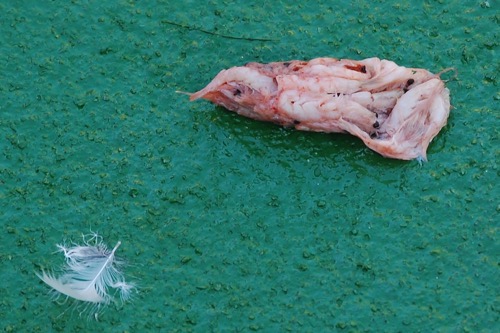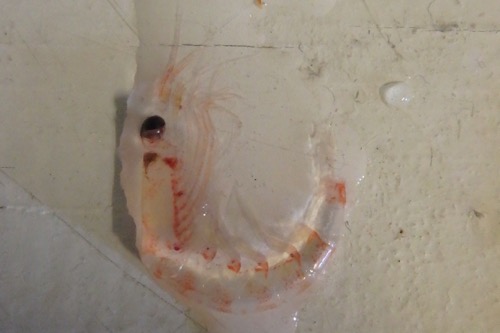Another Thank You
In my haste to post yesterday's journal about the PolarConnect Event, I forgot to say a special THANK YOU to our Network Administrators Chris Linden and Valerie Warner for their help in making sure that I had as much connectivity as possible during the event.
Science Update
It is slow going on the RVIB Palmer because of the thick ice in this area. We are breaking thick ice by putting the ship into reverse and moving forward to essentially ram the ice. The process continues until we either reach a sampling station and stop to assess the options or we reach thinner ice and can move at a faster speed. We did reach a sampling station last evening and the RVIB Palmer was able to use thrusters and boat maneuvers to create a few water holes in the ice. Luckily, these holes remained open long enough to send out the rosettes and collect samples. The science team worked late into the evening to process these samples.
 The trace metal CTD rosette is carefully lowered into the ice hole created by the RVIB Palmer. This cast went to approximately 1500m/4500ft and took approximately an hour and a half. The ice hole stayed open through the entire cast.
The trace metal CTD rosette is carefully lowered into the ice hole created by the RVIB Palmer. This cast went to approximately 1500m/4500ft and took approximately an hour and a half. The ice hole stayed open through the entire cast.
Today, we are sampling from Incubations 2 & 3. This process is not hindered by the ice because everything we need is inside the ship. The plan is to head towards another sampling station, but we do not have a specific ETA at this time. At one point overnight, the ship only moved approximately .7 miles in 4 hours, so it may take a while to get to the next location. You can check out the ice breaking process by watching the video in yesterday's journal.
Antarctic Food Web
Organisms in an ecosystem are closely associated with each other because of the energy required for life. This relationship can be shown using a simple diagram called a food web.
 Antarctic krill (far left side) are the keystone species of the Antarctic food web. Notice the large number of red lines that show the flow of energy from the krill to species like whales, seals, squid and birds. Without the success of the krill, the collapse of the entire ecosystem is possible.
Antarctic krill (far left side) are the keystone species of the Antarctic food web. Notice the large number of red lines that show the flow of energy from the krill to species like whales, seals, squid and birds. Without the success of the krill, the collapse of the entire ecosystem is possible.
Many people look at a food web and begin pointing out who is eating whom. While this is one way to look at a food web, ecologist use food webs to look at the energy available for the system. This energy originates from the sun. Light energy is converted into chemical energy (or food) through the process of photosynthesis. This means that every ecosystem contains organisms that are able to convert light into chemical energy. In the ocean, phytoplankton are essential for this process. On land, plants and trees are responsible for this connection. Energy is then distributed to other parts of the ecosystem as organism eat. If you were able to participate in the PolarConnect event you heard me talk about the importance of diatoms in the Antarctic food web. Diatoms are essential for the connection between the sun's energy and the energy needed for life (flow of energy). There are, however, many other organisms that are important for the success of the ecosystem. One organism that plays a major role in the Antarctic food web is the Antarctic krill.
Clues
In some of our recent sampling stations, we have seen large numbers of crabeater seals scattered over the ice, large groups of penguins on distant shores and many seabirds flying overhead. Crabeater seals, penguins, and seabirds (like petrels and albatross) eat Antarctic krill as a major part of their diet. Is seems logical that we have also seen lots of Antarctic krill in these areas. They have been filling up the waters on the flow-through deck incubators, clogging the filters for the flow-through sampling system in the Hydro Lab, and dirtying the decks due to birds that may have taken more than they could handle.
 This compacted pile of partially-digested krill was most likely deposited on the deck of the RVIB Palmer by a seabird that didn't have quite enough room in its digestive system. Krill is a key food source for many animals in Antarctica.
This compacted pile of partially-digested krill was most likely deposited on the deck of the RVIB Palmer by a seabird that didn't have quite enough room in its digestive system. Krill is a key food source for many animals in Antarctica.
Antarctic Krill (Euphasia superba)
 Antarctic krill have a hard, clear exoskeleton and some red coloration throughout their bodies. When the krill feed on phytoplankton, you can also see a small green tint in the middle of their bodies – a stomach full of diatoms!
Antarctic krill have a hard, clear exoskeleton and some red coloration throughout their bodies. When the krill feed on phytoplankton, you can also see a small green tint in the middle of their bodies – a stomach full of diatoms!
Antarctic krill are small, free-swimming crustaceans that feed on phytoplankton (like diatoms) and zooplankton (like copepods). Antarctic krill are one of at least 85 known species of krill found world-wide. They are incredibly abundant in Antarctica, with a biomass estimated at 125-725 million tons throughout the year. They are circumpolar (found around the entire continent) to this region.
 Antarctic krill can range in size up to about 6cm/2.5inches in length. Many of the krill seen on this research cruise are large, however, you can see the smaller krill on the far right of this image.
Antarctic krill can range in size up to about 6cm/2.5inches in length. Many of the krill seen on this research cruise are large, however, you can see the smaller krill on the far right of this image.
Antarctic krill facts:
- Adult length: ~6cm/2.5inches
- Adult weight: 2grams/0.071oz
- Life span: 6 years
- Hard, clear exoskeleton (requires a molt every 13-20 days as they grow).
- Live in large schools (swarms) of millions or even billions of individuals. Some of these swarms turn the water a red/orange color and may even be seen from space!
- Diet: phytoplankton and zooplankton from open waters and ice-algae scraped from the bottom of the fast ice and floating sea ice.
- Young krill spend most of their life under the pack ice for protection.
- Krill migrate vertically through the water column (drop to deep water during the day and rise to the surface at night).
- Krill use legs on their thorax (main body segment) to capture and hold plankton while eating. These legs are called thoracopods
 Krill have legs on their thorax (main body segment) called throacopods that act as a 'feeding basket' to hold phytoplankton while they feed. This image shows these krill parts magnified 10 times their normal size. Photo courtesy Maia Theophanis.
Krill have legs on their thorax (main body segment) called throacopods that act as a 'feeding basket' to hold phytoplankton while they feed. This image shows these krill parts magnified 10 times their normal size. Photo courtesy Maia Theophanis.
Keystone Species
Antarctic krill are the keystone species of the Antarctic ecosystem. Keystone species are considered the structural support of an ecological community. Changes to the keystone species population can have an huge impact on the entire food web – even a collapse of the food web and decline of most species. Keystone species can be invertebrates like krill, wasps, and sea stars, or vertebrates like weevils and sea otters. The designation depends on the complex interactions within the ecosystem.
Because Antarctic krill are vital to the success of the Antarctic ecosystem, it is important that their populations remain high. In 1982, a number of countries participated in the Convention on the Conservation of Antarctic Marine Living Resources. During this meeting, a commission was established to manage the conservation of marine life in the Southern Ocean. This commission (CCAMLR) recently increased oversight of the krill fishery in this area. Krill are fished for products like feed for farmed fish and nutritional supplements (krill oil). While the krill fishery has grown slowly in this region, it is important to make sure that the fishery does not out-compete the natural predators in this area. Krill are vital to the diets of so many animals in Antarctica that a massive removal of krill biomass by fisheries could impact the ecosystem.
Krill are also impacted by the effects of climate change. Ocean acidification and increased ice melt have a direct impact on the krill. The ice melt is especially alarming because krill rely on the ice for protection during the early growth stages of their life and scrape algae off the ice as adults. The continued loss of ice, increased water temperatures and changes to the water chemistry can impact this keystone species, and potentially the rest of the ecological community. The CCAMLR is tasked not only with fisheries oversight, but with conversation management of this area. This can include support of scientific research in this area to learn more about the Antarctic krill populations and the effects of climate change and other changes to their environment.


Comments